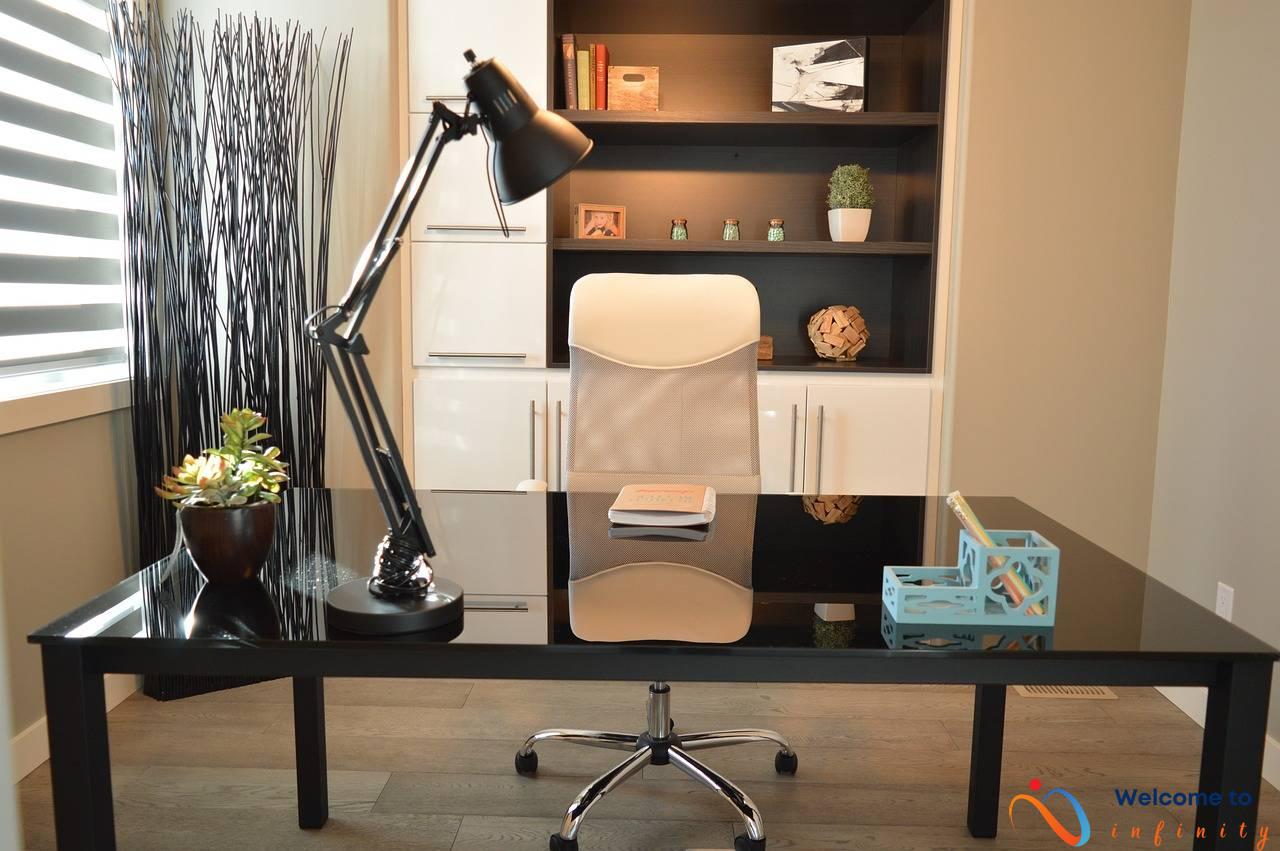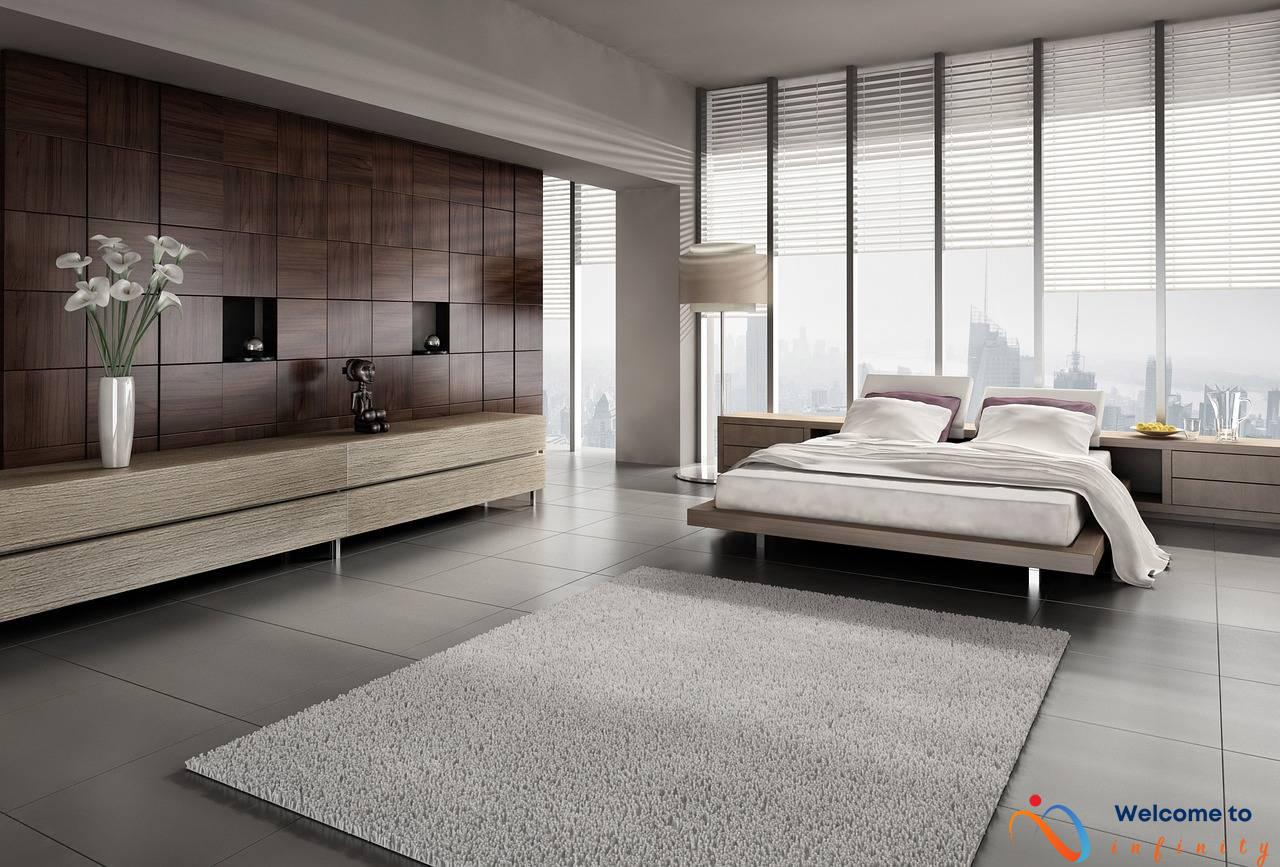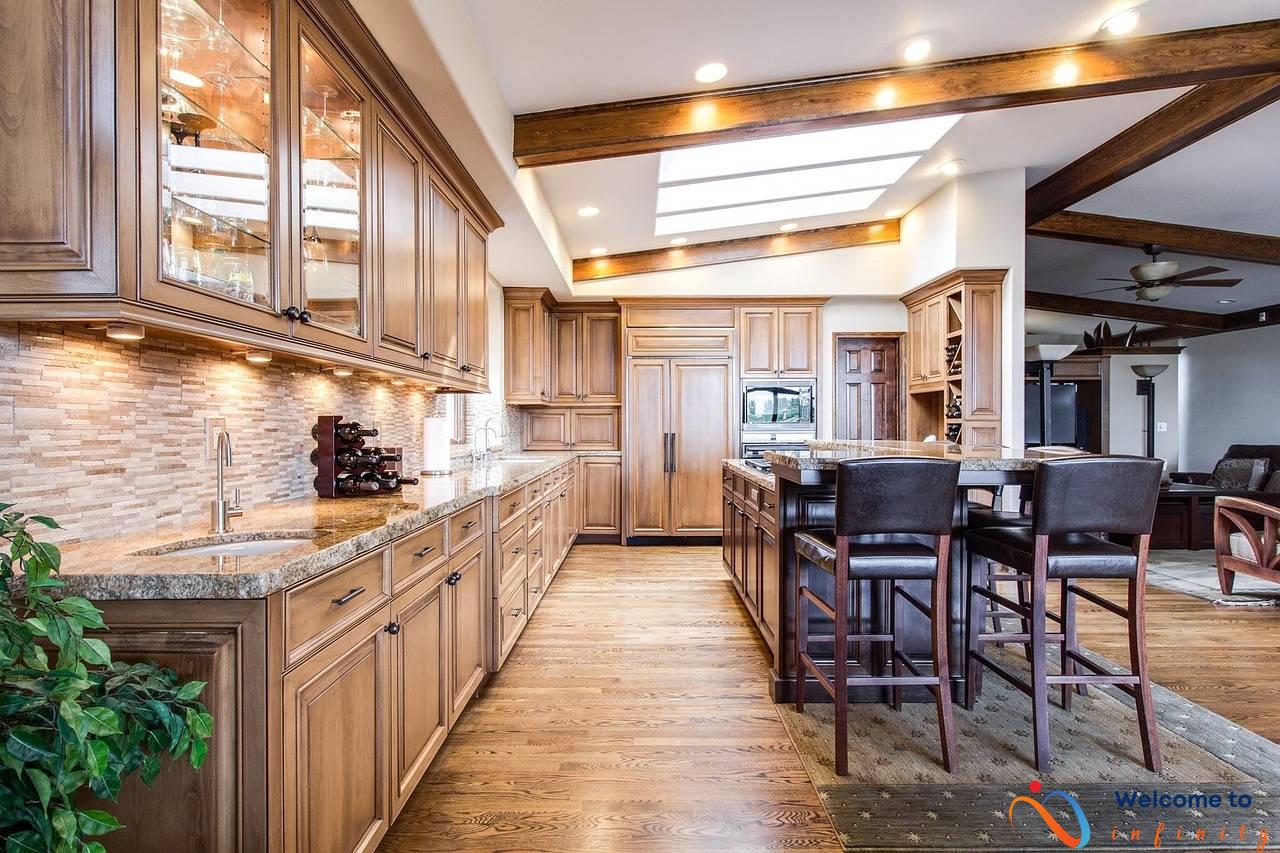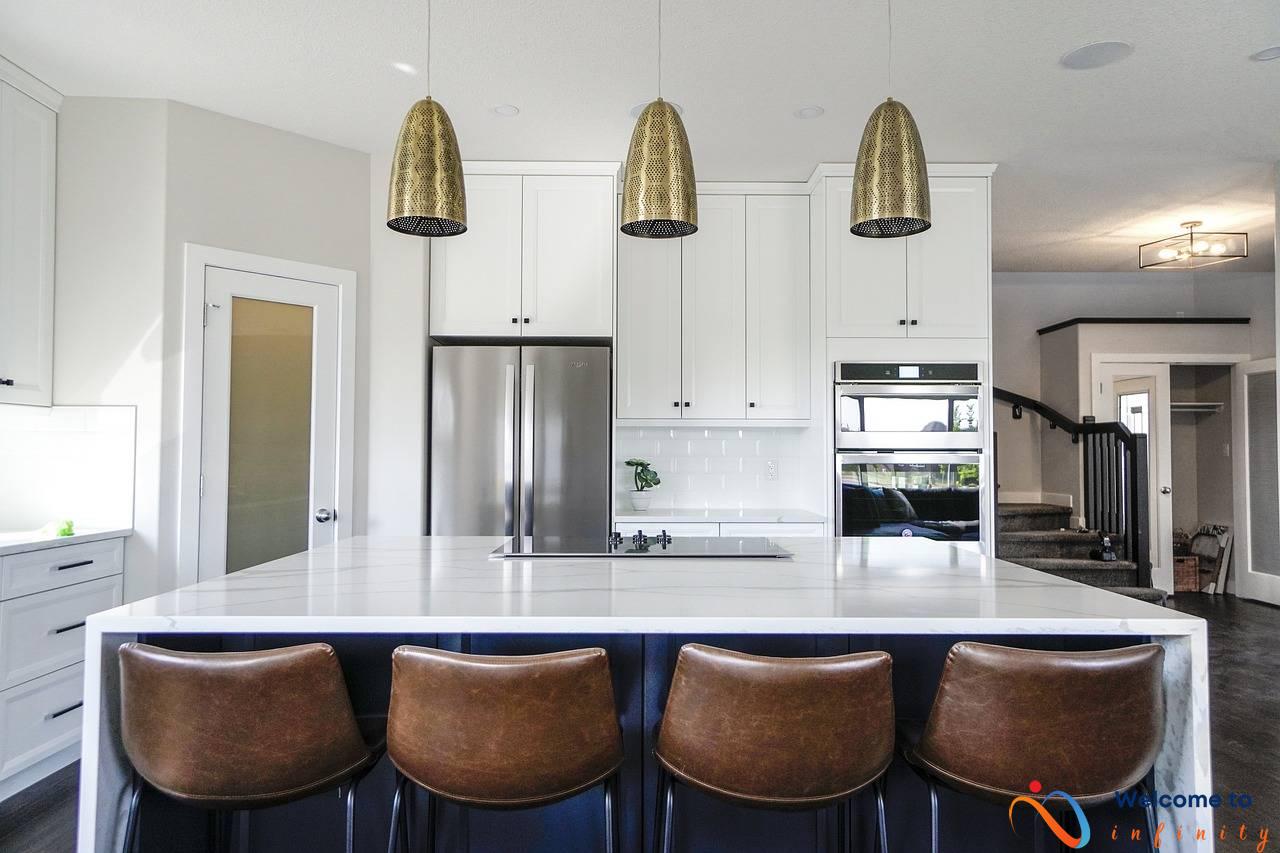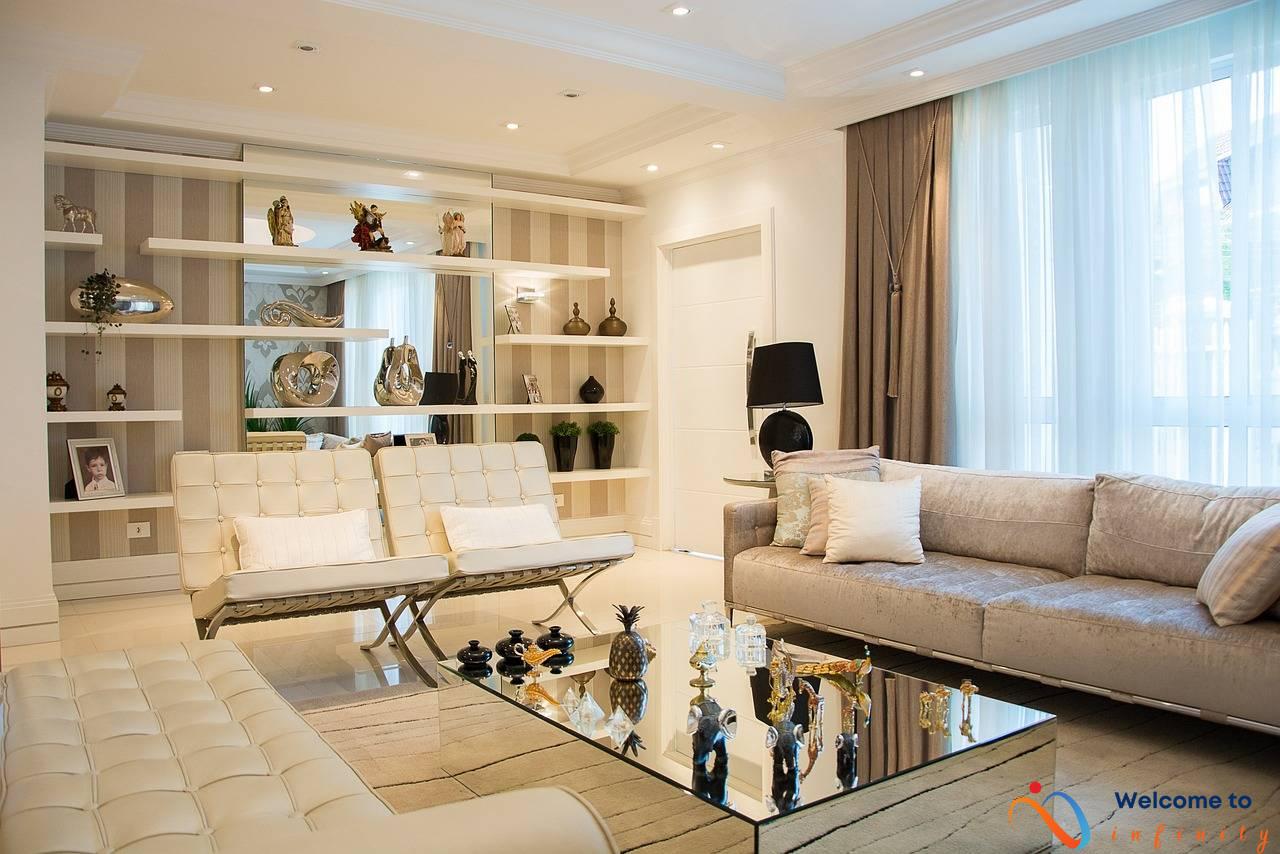Symmetry is a fundamental aspect of interior design that can bring balance and harmony to your home décor. It involves arranging objects, furniture, and design elements in an equal and proportionate way around a central axis. The result is a visually pleasing space that feels organized and cohesive. Here are some tips to achieve a perfectly symmetrical interior design:
- Identify the central axis: Start by identifying the central axis of the room, which is usually an imaginary line that runs down the middle of the space. This axis will guide you in placing objects and furniture.
- Use matching pairs of furniture and accessories: One of the easiest ways to create symmetry in a room is by using matching pairs of furniture and accessories such as chairs, lamps, and artwork. This technique creates a sense of balance and harmony and is especially effective in traditional interior design styles.
- Group objects in the center: Grouping objects in the center of a room, such as a pair of chairs or a set of vases, can create a sense of balance and symmetry. This technique works well in contemporary design styles that utilize unconventional forms of symmetry.
- Create symmetrical wall art displays: Hanging art or mirrors in symmetrical pairs on either side of a central point, such as a fireplace or window, can create symmetry and balance in a room. This technique is perfect for modern interior design styles that use asymmetrical layouts but still require some sense of balance.
- Use symmetrical lighting fixtures: Lighting fixtures such as wall sconces or pendant lights can be arranged symmetrically to create balanced and harmonious lighting in a space.
By using these tips, you can incorporate symmetry into your home décor and create a beautifully balanced and harmonious space. Whether you prefer traditional, modern or contemporary design styles, you can use symmetry to enhance the overall aesthetics of your home.
Understanding Symmetry
Symmetry is a design principle that involves creating balance and harmony by arranging objects, furniture, and other design elements in an equal and proportionate way around a central axis. This principle is widely used in interior design, as it can help create a space that looks more organized and visually pleasing.
The central axis in symmetrical interior design is usually a focal point, such as a fireplace, a window, or a piece of artwork. From this focal point, objects are arranged in a way that creates mirror images on either side. This means that the left and right sides of the room should look identical.
Symmetry can be achieved by using matching pairs of furniture, accessories, and lighting fixtures. For example, you might use two identical armchairs on either side of a fireplace, or two identical lamps on either side of a console table. Symmetry can also be achieved by grouping objects in the center of a room, such as a pair of chairs or a set of vases.
In addition to creating balance and harmony in a space, symmetry can also enhance the overall aesthetics of your home. However, it's important to note that symmetry doesn't necessarily mean boring or repetitive. Symmetry can be incorporated in unique and creative ways to add interest and depth to a room.
The Benefits of Symmetry in Interior Design
When it comes to interior design, creating a symmetrical layout can have many benefits for your home décor. One of the most significant advantages is that it can make your space appear more organized and well put-together. By arranging furniture and other design elements in a balanced and proportionate way around a central axis, you can create a sense of harmony and cohesion in your living area.
Another benefit of symmetrical interior design is that it can provide visual balance and harmony. When you have matching pairs of furniture, artwork, and accessories, it creates a feeling of symmetry and order that can be very pleasing to the eye. By incorporating symmetry into your overall design scheme, you can help to create a sense of calm and balance.
Lastly, symmetrical interior design can enhance the overall aesthetics of your home. A symmetrical layout creates a sense of elegance and sophistication, making your home feel more beautiful and inviting. Whether you prefer traditional or contemporary design styles, incorporating symmetry into your décor can help to create a look that is both timeless and stylish.
Ways to Incorporate Symmetry in Your Home Décor
Creating a beautifully symmetrical interior design is easier than you may think. One of the simplest ways to incorporate symmetry into your home décor is to use matching pairs of furniture. For instance, you can position two identical chairs facing each other on either side of a coffee table to achieve perfect symmetry.
Another way to incorporate symmetry is through the use of matching pairs of artwork and accessories. A pair of identically framed photographs or a set of matching vases can be placed on either side of a shelf or mantel to create a balanced look. You can also use matching throw pillows or cushions on opposite ends of a sofa or bed to create visual harmony.
Symmetrical lighting fixtures are also an excellent way to add balance and visual appeal to a room. For example, you can use matching wall sconces or pendant lights on either side of a fireplace or mounted artwork. This not only creates a beautifully symmetrical look but also provides balanced lighting in your living space.
If you're struggling to create symmetry in your home, try creating centered displays and groupings. For instance, you can group a set of three identically shaped and sized vases in the center of your dining table or arrange two chairs at the center of your living room. For added impact, you can place a rug or centerpiece under the grouping to create a focal point.
Incorporating symmetry into your home décor is easy and can make a huge difference in the look and feel of your space. By using matching pairs of furniture, artwork, accessories, and lighting fixtures, you can create a beautifully symmetrical interior design that reflects your unique style and personality.
Matching Pairs of Furniture and Accessories
One way to achieve symmetry in home décor is by using matching pairs of furniture and accessories. Pairing identical chairs, lamps, or artwork can create a sense of balance and harmony in a room. This can be particularly effective in living rooms, bedrooms or any space that requires balanced composition.
When using matching pairs of furniture and accessories, it is important to place them opposite each other, creating a central axis. This can be a focal point in the room, such as a window or fireplace. By arranging identical objects on either side of the axis, it creates a balanced and cohesive look.
The use of matching pairs of furniture and accessories is versatile and can be incorporated into any design style. In traditional design, pairs of furniture such as sofas or armchairs are commonly used, while in contemporary and modern design, matched pairs of lighting fixtures or decorative accessories can create subtle symmetry.
If using matching pairs of furniture and accessories, it is important to select pieces that are identical or very similar in size, shape, and style to maintain balance and harmony in the room. This can also help to prevent one object from overpowering the other, as they will be equal in composition.
In conclusion, using matching pairs of furniture and accessories is a simple yet effective way to create symmetry and balance in home décor. This technique can be used in any room and design style, creating a cohesive look that is pleasing to the eye.
Centered Displays and Groupings
When it comes to creating symmetry in your home décor, centered displays and groupings can be a great way to create balance and harmony. One way to achieve this is by placing a pair of chairs or a set of vases in the center of a room. This will create a focal point and a sense of symmetry that draws the eye.
Another way to use centered displays and groupings is by arranging a collection of objects in a symmetrical fashion. For example, you could group a set of picture frames or decorative plates in the center of a wall to create a visually pleasing display.
When creating a centered display or grouping, it's important to keep in mind the placement and balance of objects. You can use different sizes and shapes to create interest, but make sure they are arranged in a way that maintains symmetry and balance.
Additionally, using a table or other furniture piece as the central point can provide a foundation for creating a symmetrical grouping. You can then arrange objects such as lamps, books, and decorative items in a balanced way around the table.
Overall, centered displays and groupings are a great way to add a sense of harmony and balance to any room in your home. By using symmetrical arrangements, you can create a visually appealing and cohesive design that will make your space feel welcoming and inviting.
Symmetrical Wall Art and Mirrors
One of the easiest ways to incorporate symmetry in your home décor is by hanging symmetrical pairs of wall art and mirrors. This works particularly well in living rooms, dining rooms, and bedrooms where the wall is your blank canvas.
To achieve a symmetrical look, hang identical pieces of art or mirrors on either side of a central point, such as a fireplace or couch. You can also incorporate symmetry in your gallery wall by using identical frames and arranging them symmetrically.
If you're not a big fan of identical pieces, you can also create symmetry by hanging two different pieces with similar shapes and sizes. For example, hang a circular mirror on one side of the wall and a circular piece of artwork on the other. This creates a sense of balance while also adding visual interest to the space.
Note that when hanging symmetrical pieces, it's important to ensure they are at the same height and distance from the central point. You can use a measuring tape and a level to ensure everything is perfectly balanced.
Overall, hanging symmetrical wall art and mirrors is an easy and effective way to add balance and harmony to your home décor. Give it a try and see how it transforms your space!
Symmetrical Lighting Fixtures
Lighting plays a crucial role in interior design, and symmetrical lighting fixtures can enhance the ambiance of any space. Using symmetrical lighting fixtures such as wall sconces or pendant lights can create a balanced and symmetrical look in a room. These fixtures can be hung on either side of a central point, such as a fireplace or a piece of artwork, creating visual balance and harmony.
Another way to incorporate symmetry in lighting is to use matching table lamps or floor lamps on either side of a sofa or bed, creating a cohesive and balanced look. Additionally, using identical overhead lighting fixtures in a large room can create a sense of symmetry and balance.
When choosing lighting fixtures, it's important to consider the style and scale of the fixture in relation to the room. For example, in a small room, using large and ornate wall sconces may overpower the space and create an unbalanced look. Instead, opt for smaller fixtures or consider using a pair of matching table lamps.
Overall, incorporating symmetrical lighting fixtures can enhance the overall aesthetic of a room and create a sense of balance and harmony. It's important to carefully consider the placement and style of the fixtures to achieve the desired effect.
Symmetry in Different Design Styles
Symmetry plays an important role in different interior design styles, be it traditional, modern, or contemporary. In traditional design, symmetrical layouts and matching furniture are quite common. For example, a formal living room might have two identical sofas facing each other, with matching coffee tables and lamps on either side. Traditional design also often incorporates symmetrical layouts in bedrooms with two identical bedside tables and lamps on either side of the bed.
Modern design, on the other hand, often incorporates asymmetrical layouts to create an edgier feel. However, small elements of symmetry can still be utilized in modern design to create balance and harmony. For example, a modern living room might have a large asymmetrical sectional couch facing a large asymmetrical coffee table, but still, incorporate symmetry through matching side tables and lamps on either side of the couch.
Contemporary design often incorporates unique and unconventional forms of symmetry, using asymmetrical furniture and centering artwork on a wall. The asymmetry in contemporary design is often more subtle, using different sizes and shapes of furniture and decor, and finding ways to balance them out. For example, in a contemporary dining room, a large asymmetrical chandelier might be balanced out by two identical sets of dining chairs on either side of the table.
Incorporating symmetry into different design styles can help create a sense of balance and harmony in a space, regardless of the overall style. It can also provide visual interest and a sophisticated look to your home décor.
Symmetry in Traditional Design
Traditional design is characterized by its timeless elegance and balance. It often incorporates symmetrical layouts and matching furniture to create a sense of harmony and order in the room.
One of the most common ways to achieve symmetry in traditional design is through the use of matching furniture sets. This can include pairs of armchairs or sofas, identical side tables, or even a pair of lamps placed symmetrically on either side of a fireplace.
In addition, traditional design often features symmetrical arrangements of artwork and décor. A common example is a pair of framed prints that are hung side by side above a sofa or console table. Another approach is to create an arrangement of matching vases or figurines, which can be centered on a mantelpiece or placed symmetrically on a shelf.
Incorporating symmetry into traditional design can help create a sense of visual balance and order. It can make a room feel more welcoming and comfortable, providing a sense of serenity and peace.
Symmetry in Modern Design
Modern design has been characterized by its asymmetrical layouts, minimalistic color schemes, and clean lines. In this type of interior design, symmetry is often used in small ways to create balance and harmony within a space.
One way to utilize symmetry in modern design is by incorporating matching pairs of furniture and accessories. A set of identical lounge chairs in a room can add a sense of balance and order. In addition, using equal-sized and positioned artwork or decorative objects on both sides of a room can create a visually balanced space.
However, modern design often encourages breaking symmetry deliberately to create a dynamic and interesting space. For example, using statement pieces of furniture that are non-symmetrical or hanging artwork in a seemingly random pattern adds an element of unpredictability to the space while still maintaining a sense of balance and harmony.
Another way to use symmetry in modern design is by utilizing color. A balance of color in a room can create a cohesive and harmonious feeling. Additionally, using similar materials and textures in design elements can create unity and harmony.
In conclusion, modern design often relies on asymmetric patterns, however, can still benefit from the use of symmetry in creative and subtle ways. Whether incorporating matching pairs of furniture or playing with color and texture, designers can use symmetry to create balance and harmony in any modern space.
Symmetry in Contemporary Design
Symmetry is not always about perfectly matched pairs and balanced layouts. In contemporary design, symmetry can take on a more unique and unconventional form. Asymmetrical furniture, for example, can still create a sense of balance and harmony in a space by strategically placing it in relation to other pieces.
Centering artwork on a wall can also create a sense of symmetry in a contemporary design. Instead of perfectly symmetrical pairs, artwork can be arranged in an intentionally unbalanced way that still creates a sense of visual harmony.
- Contemporary design also often utilizes irregular shapes and forms, which can create a sense of balance and symmetry when arranged thoughtfully with other elements in the space.
- Another way that contemporary designs incorporate symmetry is through the use of repeating patterns or textures.
- Lighting fixtures can also be used in a symmetrical way to create balance in contemporary design.
Overall, contemporary design allows for more creative and unique forms of symmetry while still maintaining a sense of balance and harmony in the space. Whether using asymmetrical furniture, centered artwork, or repeating patterns, symmetrical design in contemporary interiors can bring a sense of order and visual interest to a space.






